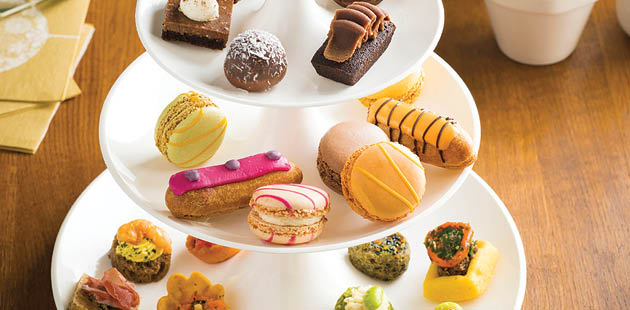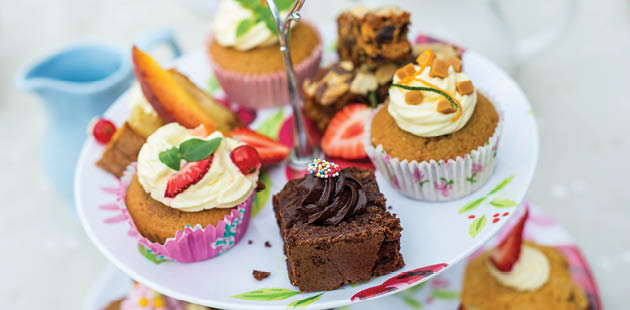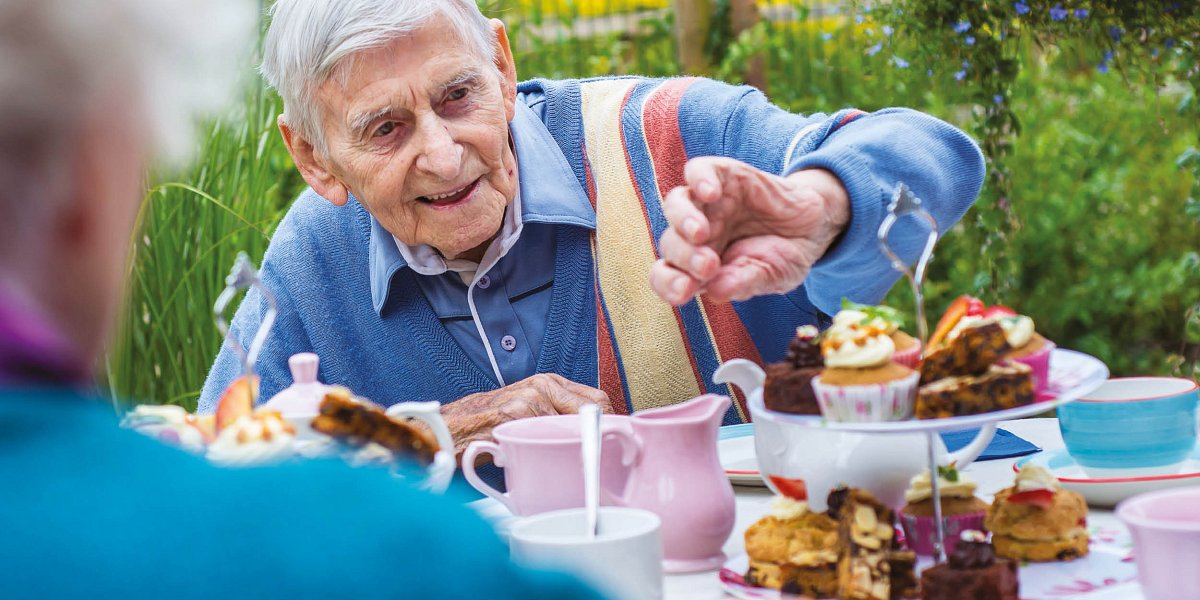Time for afternoon tea: A fresh take on a classic
It’s already a British classic but, as Lauren Fitchett discovers, there are plenty of ways to serve up afternoon tea with a twist.

A Sunday roast, fish and chips Friday or perhaps curry night – however adventurous you are with your menus, you know there are certain meals which always go down well. Afternoon tea is one.
At Care UK, Andrew Mussett, chef and hotel services manager, says chefs take pride in creating memorable afternoon teas, often complete with decorations and costumes – earlier this year, the team at one home created a royal residence, complete with a visiting corgi.
“Quite apart from the obvious nutritional benefits of the various elements of the treat, afternoon tea offers a number of other gains,” he says. “It is a prompt for reminiscence – many residents in our homes live with dementia.”
The menus are often quite traditional – small cakes, finger sandwiches and scones – though Mussett says they’ll sometimes add fresh fruit for a hydration boost or a glass of something sparkling for special occasions. “In a care home setting, the key is to make it as authentic as possible while keeping those with special dining requirements safe,” he explains. “Nice crockery, tea poured from proper China pots and food attractively served so that people can help themselves – just as they would in the Ritz.
“Our chefs have even developed the skills to be able to create authentic looking scones and cakes for people who require a modified diet to minimise the risk of choking, using advanced piping techniques.”
At White Oaks, run by the Compass Group UK and Ireland, afternoon tea is a weekly affair, held on Sundays after a roast. “Our offer varies each week but the range generally includes staples such finger sandwiches, homemade savoury treats like sausage rolls, cheese straws and vol au vents followed by scones served with jam and cream, a delicious gateau or the ever-popular strawberries and cream, all served with pots of tea,” says Felicity Townsend, account lead. “We sometimes diversify offers with items such as hot buttered crumpets, pigs in blankets, savouries on toast and toasted tea cakes.”
One of afternoon tea’s strength is its flexibility – it’s easy to swap out items and introduce themes, from Christmas to Halloween and 1960s to royalty. “Traditionally seen as a real treat amongst older generations, organising afternoon tea creates a special occasion – one which may encourage residents otherwise uninterested in food, to get involved in planning,” says Andy Williams, national account manager at Creed Foodservice. “Asking residents to talk about their food nostalgia not only helps stimulate precious memories, but also allows care caterers to understand what makes residents tick when it comes to what is on their plate.”
There’s also plenty of opportunity to cater for varied diets, as Scott Oakes, commercial manager for St Pierre Groupe’s Baker Street says – caterers can use fruit for health and hydration benefits, cream and butter to up calorific intake and swap traditional items for gluten-free varieties.
“The sandwiches and cakes that make up afternoon tea are gentle on the mouth to aid those who struggle to chew hard foods and small, bitesize pieces are ideal for those with small appetites. It’s the perfect all-rounder for a special occasion in the care home – or just for a twist on an ordinary food service,” he adds.
Anna Sentance, gourmet marketing manager at Callebeaut UK and Ireland, agrees that afternoon teas can be tweaked. She suggests a chocolate theme, pointing to research which shows 45% of consumers would pick a chocolate dessert above other flavours. “Afternoon tea can be prepared for groups so it can offer an opportunity for a themed day to celebrate a special occasion,” she says. “Afternoon tea can prove to be a special luxurious treat for residents, creating an experience, whilst remaining in the comfort of their care home. Secondly, as residents may have different dietary requirements, elements of an afternoon tea can be catered to suit different needs and preferences.”

Canapés from Tipiak
Tea with a twist
So how can you put a fresh spin on a tried and tested favourite? “Decoration and table dressing is key for creating a fun and convivial environment – consider using colourful tablecloths, napkins and tableware to create a cheerful setting,” Williams says. “Bunting and posters can also help change a space at very little cost. If possible, changing the location of the tea from what is normal can help create a sense of occasion – utilise outdoor picnic spaces and communal areas that might not normally be frequented for mealtimes.”
He suggests using music –perhaps a 1950s afternoon tea with an Elvis entertainer – or a nostalgic quiz to evoke memories. In winter, chefs can introduce Christmassy flavours and use traybakes to keep food preparation time down. “Picking a key moment in history and tying in an afternoon tea with it is a nice way to bring back memories and create a talking point, alternatively picking a modern celebration can help get residents engaged in current events,” he adds.
Townsend agrees that setting can shake up what’s traditional. “In the summer when the weather is warm enough, we often have residents and their visitors outdoors in the garden and so serve afternoon tea outside,” she says, adding that it provides a chance to add in barbecue items, such as mini burgers or hot dogs.
Mix up your sandwich fillings for a simple twist. “Try introducing global flavours, whether Coronation chicken or German-style smoked cheese, or theme the occasion in line with big sporting events or national occasions,” Oakes suggests. “Even hot sandwiches and burgers (cut for convenience) can be introduced – there are no rules.”
Going plant-based can also introduce residents to new diets. “Vegan food is an increasingly important part of the foodservice menu, and a vegan traditional afternoon tea can be delicious,” says Ian Leadbetter, national corporate chef, Rational UK. “It’s quite easy to make vegan ‘clotted cream’ and dairy-free plant butter is widely available. Traditional scones, with butter, egg wash and milk, don’t fit the bill but there are plenty of vegan scone recipes around."
Rich and indulgent
From butter to cream, afternoon tea provides the perfect opportunity for fortification. “Afternoon tea is about getting together, chatting and having quality time,” says Jean Cattanach, marketing controller at Lakeland Dairies. “It can also be an occasion to try something new, and to treat yourself – all pleasures that make a difference to everyday wellbeing in any setting. For those in a care setting that may need additional fortification it is an ideal opportunity to provide some extra nutrition in a fun way.”
She says Lakeland Dairies has been working with the National Activity Providers Association to create a guide to afternoon products called Scrumptious Scones, which offers ideas around Lakeland Dairies and Millac products, as well as recipes, puzzles and quizzes.

A Care UK afternoon tea
Getting prepared
Elements of afternoon tea can be prepared in advance and caterers can rely on frozen treats to up convenience. “When it comes to the sweet side of afternoon tea, macarons are really in vogue and an essential ingredient of any afternoon tea,” explains Marie-Emmanuelle Chessé, international development project manager at Tipiak. “Tipiak’s authentic classic French macarons and pop macaron fruits are gluten-free and suitable for vegetarians – offering a delicious option for all your residents, including those who are coeliac and gluten-free.”
Preprepared frozen products makes it easier for caterers to lay on a first class spread, says Central Foods managing director Grodon Lauder. “There will always be a constant supply of ‘fresh’ delicacies,” he says. “Frozen pre-prepared items are used in pretty much every professional kitchen now for convenience and to help reduce waste. Afternoon tea is an occasion that is always looked forward to in any care home. It’s a social event but also a key chance to offer extra calories and hydration to residents. Choose mini or bite-sized ingredients for your afternoon tea to help tempt those with smaller appetites.”
From a trip down memory lane and a festive theme to introducing new treats, there is unlimited room for creativity when it comes to your afternoon teas. If you can, why not try and offer something different every month, to really make them a focal point of your home’s calendar.











